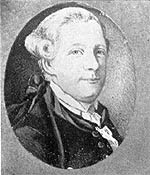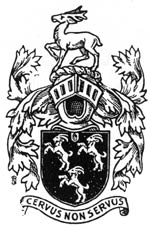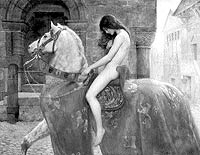Godiva rides again - on Front St.?
By Alun HughesWhy is Thorold named "Thorold"? That was the question put to five city residents in last week's "Speak Your Mind."
Two had no idea, but the other three said Thorold is a man's name, and one thought he was a John or Charles Thorold from Britain; which is about as close as you can get, for Thorold is indeed named after an Englishman called John Thorold.
Sir John Thorold, 1634-1815. This has long been known, but there is much about the man and his family history that is less familiar, not least the link to the legendary Lady Godiva, who rode her horse through the streets of Coventry clad only in her long blond tresses…
Thorold came into existence in 1788 when surveyor Augustus Jones laid out the northern part of the township. At the time it was known as Township No. 9, and it was not until about 1793, following the creation of Upper Canada, that it was named. One of the earliest documented uses of the name Thorold is in the field notes of Thomas Welch, who completed the township survey in mid-1794.
The township's namesake was Sir John Thorold, 9th. Bt., of Syston Park north-east of Grantham, Lincolnshire, who lived from 1734 to 1815. Sir John was a lesser noble (the ninth Baronet in a line extending back to 1642), a landowner and a Member of Parliament, serving Lincolnshire from 1779 to 1796. And, it should be noted, he pronounced his name "Thurrald." (How the township came to be named for him is a story in itself, and that I shall reserve for my next column.)
His main claim to fame was the magnificent collection of ancient books amassed by him and his son John Hayford Thorold. Hailed as "two of the greatest collectors in the shining era of English bibliomania," their library contained some of the rarest incunabula in existence - including a copy of the Gutenberg Bible, which set a record when it sold for £3200 in 1884 (it has since fetched over a million). Books bearing the Syston Park bookplate appear regularly in the lists of the world's leading antiquarian book dealers.
The bookplate shows the family coat of arms, which is also the insignia of the City of Thorold. In heraldic jargon it is described thus: "Arms - sable: three goats salient argent. Crest - a roebuck passant argent, attired or." In layman's terms it says: a black shield bearing three silver goats leaping, surmounted by a silver stag walking, with gold antlers. The Latin motto Cervus non Servus means "the stag is not a slave" (an appropriate slogan perhaps for loyal Thoroldites to proclaim next time St. Catharines threatens amalgamation).
The Thorold arms also carry two marks of Baronetage: a knight's helmet, full-faced with the visor raised, and a "sinister hand, couped at the wrist gules," meaning a red left hand cut off at the wrist. Just visible at the top of the shield, this is the of Ulster, a powerful Irish/Celtic symbol born of a legendary race by two giants across the Irish Sea. The first to touch land would possess Ulster, and the giant who fell behind cut off his hand and tossed it ashore to claim victory. The appears on a Baronet's shield because when the title was created by James I in 1611 his aim was to raise money to support the plantation of Ulster.
The first Baronet in the family was Sir William Thorold. Born in 1591, he was knighted by James I at age 16, became Sheriff of Lincolnshire in 1632, served several years as MP for Grantham, and took the Royalist side in the Civil War. He was made a Baronet on August 24, 1642, just two days after Charles I raised his standard at Nottingham in a formal declaration of war. But he suffered dearly for his loyalty - Marston Hall, his home north-west of Grantham, was devastated by the Roundheads, and he had to pay £4160 to the sequestrators of his estate.
Thorold family coat of arms and The of Ulster An unbroken Thorold line can be traced back from the present day through Sir John and Sir William to Sir Richard Thorold of Selby, Yorkshire, who lived in the mid-fourteenth century. He married into a Lincolnshire family from Marston, which then became the Thorold family seat. It remained there until Sir John built a magnificent new house at Syston in the 1770s.
There are references to Thorolds much earlier than Sir Richard, though their link to him is uncertain. In 1052, 14 years before the Norman Conquest, a Theroldus de Buckenhuld was Sheriff of Lincolnshire, and this entry in the Domesday Book of 1086 - "Thoraldr the Sheriff gave his land to St. Guthlac's for his soul" - probably refers to him. Since Thor is the Norse god of thunder, the true origins of the name may lie lost in the mists of Scandinavian history.
Sheriff Thorold is of particular interest, for he was either the father or brother of Lady Godiva, wife of Leofric III, Saxon Earl of Mercia.
Lady Godiva by John Collier. When she urged her husband to reduce the taxes burdening the people of Coventry, he consented only on condition that she rode through the market. Godiva called his bluff and paraded in the buff - or so legend has it. A later embellishment tells of Tom the tailor who watched her ride by, while others averted their gaze. He was struck blind for his effrontery, and is immortalized in the expression Peeping Tom.
In 1955, Thorold residents may have seen the film "Lady Godiva" at the Tivoli. Maureen O'Hara starred in the title role, A.E. Gould-Porter played Thorold the Sheriff, and a certain Clint Eastwood had a bit part called First Saxon! So when Thorold stages its first annual re-enactment of Lady Godiva's ride down Front Street this summer, Clint Eastwood can be the parade marshall. All we need now is a volunteer for the Lady herself…



